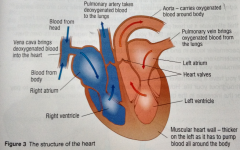![]()
![]()
![]()
Use LEFT and RIGHT arrow keys to navigate between flashcards;
Use UP and DOWN arrow keys to flip the card;
H to show hint;
A reads text to speech;
31 Cards in this Set
- Front
- Back
|
Why is a transport system vital?
|
Direct diffusion is not enough since most of our cells are a long way from a direct source of food or oxygen.
|
|
|
What is the function of the blood circulation system?
|
To supply your body cells with glucose and oxygen for respiration and to remove waste materials that are the by-products of respiration.
|
|
|
What do the arteries and veins do?
|
Arteries carry oxygenated blood away from the heart to the organs of the body.
Veins carry deoxygenated blood to your heart from the organs. |
|
|
How are your heart muscles supplied with oxygen?
|
Via the coronary arteries.
|
|

|

|
|
|
What is the function of valves?
|
They prevent backflow of blood.
|
|
|
What is the sinoatrial node?
|
A pacemaker.
|
|
|
What is a disadvantage of an artificial pacemaker?
|
You need regular medical check-ups throughout your life.
|
|
|
What are the disadvantages of an artificial heart?
|
They won't work permanently. You must carry it around with you. Blood could clot in the artificial heart, killing the patient.
|
|
|
How do stents work to help with coronary heart disease?
|
A tiny balloon is inflated to open up the blood vessel and stent at the same time. The balloon is removed but the stent stays, allowing blood to flow freely. Stents can be put in place without general anaesthetic.
|
|
|
How does bypass surgery work to help with coronary heart disease?
|
Doctors replace the narrow or blocked coronary arteries with bits of vein from other parts of the body. This works for badly blocked arteries where stents can't help. This surgery is expensive and involved a general anaesthetic.
|
|
|
What are the disadvantages of a mechanical valve?
|
The patient must take medicine for the rest of their life to prevent their blood from clotting around it.
|
|
|
What are the disadvantages of a biological valve?
|
They only last 12-15 years.
|
|
|
What do you find in plasma?
|
Red blood cells, white blood cells, and platelets. Also many dissolved substances around your body including waste carbon dioxide being carried to the lungs, urea (a waste product from the breakdown of proteins) being carried to the kidneys, and all the small, soluble products of digestion passed on from your small intestine.
|
|
|
What are adaptations of red blood cells?
|
They are biconcave discs which gives them an increased surface area to volume ratio over which the diffusion of oxygen can take place.
They are full of a red pigment called haemoglobin that can carry oxygen. They don't have a nucleus, making more space to pack in haemoglobin. |
|
|
What do white blood cells do?
|
They form a part of the body's defence system. Some form antibodies against microorganisms, some form antitoxins against poisons made by microorganisms, and others engulf and digest invading bacteria and viruses.
|
|
|
What are platelets and what do they do?
|
They are small fragments of cells that have no nucleus. They help the blood to clot the site of a wound.
|
|
|
What is blood clotting?
|
A series of enzyme controlled reactions that result in the change of fibrinogen into fibrin. This produces a network of protein fibres which captures lots of red blood cells and more platelets to form a jelly-like clot.
|
|
|
How do we reduce the risk of a transplanted organ being rejected?
|
The match between the antigens of the donor and recipient must be as close as possible.
Immunosuppressant drugs must be given to the recipient for the rest of their lives, however this prevents patients from dealing effectively with infectious diseases. They don't last forever and will fail so the patient needs another transplant. |
|

|

|
|
|
Carbohydrates are broken down by ... and ... is an example of one.
|
Carbohydrases
Amylase |
|
|
The breakdown of protein into amino acids is done by ...
|
proteases
|
|
|
Lipids are broken down into fatty acids and glycerol by ... enzymes.
|
lipase
|
|
|
What enzymes are made in your salivary glands?
|
amylase
|
|
|
What enzymes are made in the pancreas?
|
amylase
proteases lipase |
|
|
What enzymes are made in the stomach?
|
proteases (pepsin)
|
|
|
What enzymes are made in the small intestine?
|
proteases
|
|
|
How is your stomach adapted?
|
Low pH (since hydrochloric acid is produced) for pepsin to work well.
A thick layer of mucus coats your stomach walls to prevent them from being digested by the acid and enzymes. |
|
|
How does the acidic liquid leaving your stomach become an alkaline mix in your small intestine?
|
Your liver makes an alkaline called bile which is stored in your gall bladder until it is needed. As food comes into the small intestine from the stomach, bile is squirted onto it through the bile duct.
|
|
|
What does bile do to fats.
|
It emulsifies fats in your food, bile breaks up large drops of fat into smaller droplets to provide a larger surface area for the lipase enzymes to act on.
|
|

|

|

